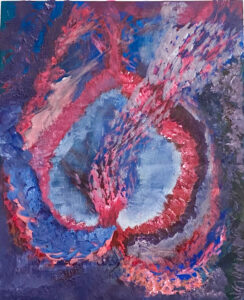
Deep
Visual Essay: Exploring Abstract Expressionism and Contemporary Abstraction in My Work
This painting embodies the emotional depth and expressive energy characteristic of the Abstract Expressionist movement, as well as elements of contemporary abstraction that explore texture, color, and form as independent elements. Abstract Expressionism emerged in the mid-20th century as a response to the desire for art that was deeply personal and emotionally driven. Artists like Jackson Pollock and Willem de Kooning used bold brushstrokes, vibrant colors, and spontaneous techniques to communicate raw emotions and create immersive visual experiences (Cernuschi, 2014).
In a similar way, my painting uses intense colors, especially variations of red, blue, and pink, to evoke feelings of passion, introspection, and transformation. The central shape, which seems to expand and contract within the canvas, invites viewers to explore the painting on a visceral level. Like Pollock’s action paintings, the energetic brushstrokes and layering techniques used in this piece create a sense of movement, as if the colors and forms are evolving before the viewer’s eyes. This approach aligns with the Abstract Expressionist aim of portraying the artist’s emotional landscape, making the act of painting itself an intimate, almost performative experience (Rosenberg, 1994).
In addition to Abstract Expressionism, this work also connects with contemporary abstraction, particularly in the way it utilizes texture and color as independent elements to build depth. Contemporary abstract artists, such as Mark Bradford, have used layering and texture to bring tactile experiences into their work, reflecting themes of identity and social commentary (Sorkin, 2015). Similarly, the textured layers in my painting invite viewers to engage physically with the work, emphasizing the materiality of paint and creating a sensory experience that transcends mere visual interpretation.
By incorporating both historical and modern approaches, this painting stands as an exploration of abstraction as a timeless language. It speaks to the idea that color, form, and texture can carry emotional weight, connecting the viewer to a shared human experience of introspection and emotional complexity.
References
- Cernuschi, C. (2014). Jackson Pollock: Meaning and significance. Cambridge University Press.
- Rosenberg, H. (1994). The Tradition of the New. Da Capo Press.
- Sorkin, J. (2015). Mark Bradford. Phaidon Press.